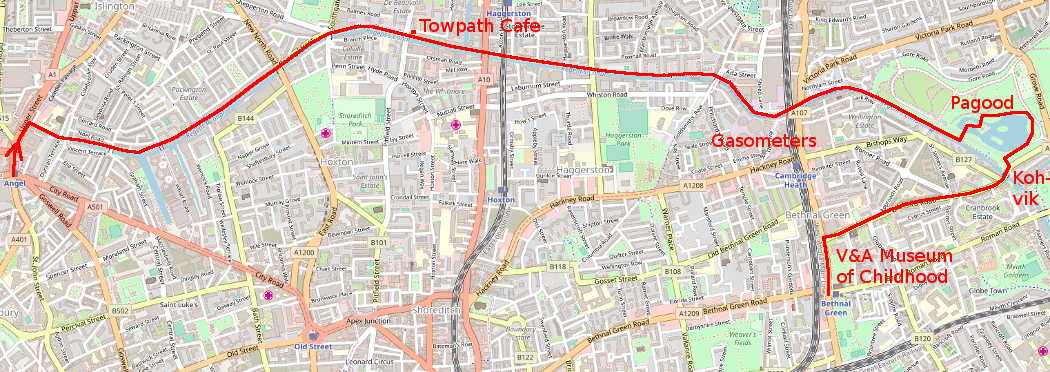

Regent's Canal is actually very long (14 km), but this time we will pass a smaller section of it. The channel is not very old in terms of history. As far back as the 18th century, grasslands were spread in the area visited today, and the place was called the London dairies. The canal is named after King George IV, who ruled the country as Prince Regent for ten years during the mental illness of his father, George III. By the way, the number three seems to be an unlucky number for rulers, so George III, Otto III of the Germans and Peter III of the Russians have gone down in history with great failures.
We will start our journey from Angel Underground station. This station is named after the tavern that once stood here. We turn right and move a hundred meters to the North-east. On this journey, we already cross the channel, but we don't notice it. The canal runs underground in a tunnel for about 800 m in this place. Soon we turn right into Duncan Street. We move to the end of the street until it looks like a park in front. In fact, depending on the time of year, the canal can already be seen through the trees. It would be more useful to move along the left bank of the canal. To get there, you have to go through a small garden gate with red stone posts and down the stairs.
The path along the canal is not very wide, but comfortably walkable. The pavement is a few meters above the water level - so that the boats do not splash pedestrians. We walk along this road for several kilometres.
For the first 30 minutes, we can observe all kinds of boats and barges and their bustling activity. Also note the many locks on the channel.
We could make the first stop to rest our legs at the nice cafe Towpath Cafe. The Proud East restaurant is also next door.
Moving 150 meters further, a dead end called Kingsland Basin turns away from the channel. It is also worth exploring, there is even a vegetable garden on board a small boat.
Now we can continue walking. After the canal turns slightly to the right, you will see large cylindrical steel trusses on the other bank. You can see a lot of these elsewhere in the city. These are former gas storages called "gasometer". Inside this truss, an open cistern rose up from below by the force of gas from the pit below, which was kept airtight by the water below. A talented invention, but these days they are no longer in use.
Going further, we reach the park. On either side of its entrance are low arched walls bearing the inscription "Victoria Park". We can enter the park from there, but in the park we turn right as soon as possible and continue parallel to the canal. After a couple of hundred meters, we reach a small square, next to which there are statues of short-tailed dogs. They are called Dogs of Alcibiades. We go another hundred meters and turn left, to the bridge that leads to the island in the middle of the little lake. On the island we see a real Chinese pagoda. We leave the island by another bridge and passing by the lake on the east side, we reach the Pavilion cafe. Another opportunity to drink coffee and have a little treat. The cafe has a gorgeous glass dome and an outdoor terrace right on the shore of the lake. We hope that your mood will not be spoiled by the fact that there was a prison camp in the same place during the Second World War.
We leave the park along Old Ford Road. On the way, we pass a restaurant serving Indian national dishes, which for some incomprehensible reason is called City of Paris. A few hundred meters further, there is a vegetarian restaurant on the right side of the road. But if you're not interested in that, look to the left instead. There is the V&A Museum of Childhood (V&A is an abbreviation well known to all Londoners - Victoria and Albert, the former queen and her husband). Probably the world's largest collection of everything you can play with as a child. If you want to visit it (it's free), the entrance is from the next crossing, Cambridge Heath Road. The end point of our walk, Bethnal Green tube station, is 200 meters south of the museum entrance. You can, of course, take a little detour across the street behind the little park to walk along the street with a nice name: Paradise Row. Before entering the Underground, notice the monument across the street - Stairway to Heaven. It commemorates the 173 people who died during the bombing of WWII right here. They did not die of the bombs, but from the struggle as they rushed to the shelter, which at the time was an unlit tube station that was still half-under construction.